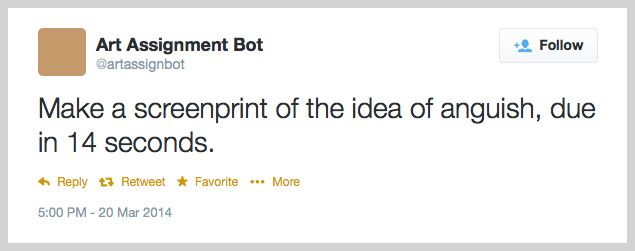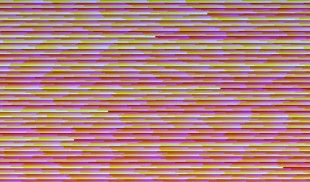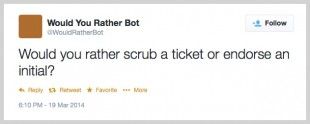
One evening last month, my laptop accidentally spilled out of its bag and violently met the concrete. Next time I turned it on, every white pixel field on my screen was replaced with a harsh magenta-and-white striped moire-like pattern. I attempted to buy airline tickets online, and the vibrancy of the optical effect was so oppressive that I abandoned that task. However, I was curious to to see its effects on my photos and artwork. To my surprise, as I thumbed through various image galleries, I found the effect to be strangely satisfying: the superimposition of stripes was unruly, psychedelic, and hysterical. I reluctantly enjoyed the experience. But the question “what if I replaced the color white with crazy stripe everywhere?” was not one I would have ever asked, not intentionally.
Jeff Thompson routinely asks those “what if” questions. I first encountered Jeff on Twitter as Art Assignment Bot, a program that challenges internet citizens to do things like “Build a 3D rendering of the idea of memory, due in 39 minutes.” I found the idea to be initially amusing, then potentially useful, and then maybe even brilliant. I later found out that Jeff was the creator of several other strangely entertaining projects: a Twitter program that responds “Really?” to random users, another that asks randomly-generated “Would You Rather?” questions, a Tumblr theme that intentionally scrambles page elements, and various seemingly pointless exercises like a vertical reading of the words in Shakespeare’s sonnets.
But this is the work of an artist, not merely a dorm-room prankster. Jeff is a painter-turned-programmer-turned-professor who manipulates code the way that Jackson Pollock manipulated paint: both with precision and playfulness. I love the way he’s using technologies as they’re not really supposed to be used, trying to break them in order to uncover what might be lurking underneath. It’s sometimes beautiful, sometimes befuddling, always fascinating. When I found out he taught at a college down the street from where I live, I asked him if he’d like to chat.
Drew Dernavich: I know you primarily as the creator of the Art Assignment Bot. What do you do for a living, officially?
Jeff Thompson: I’m the Assistant Professor and Program Director of Visual Art Technology at Stephens Institute of Technology. I’ve been teaching for a long time. That’s how I pay the bills, and I enjoy it.
D: Do you have traditional art training?
J: I started undergraduate school in Illustration, and I went to the Minneapolis College of Art and Design; they have really great graphic novel kind of program — one of the few, actually.
D: Did programming or coding come naturally?
J: The programming is totally self-taught. I got bored with painting, but I could spend all day writing software and never get tired of it. That’s how I realized that I knew I was an artist, but maybe painting wasn’t the right place to do what artists do. Does that make sense?
D: Yeah, but my brain doesn’t work that way. I would put that outside the realm of possibility, that someone who likes to draw would want to do something so technical.
J: I don’t know how it happened, but I think the computer helps me do things that I couldn’t do otherwise. Like, if I wanted to make 5 million drawings I could sit and draw for the next few years, or I could write some code that generates these things.
D: When I first saw the Art Assignment Bot I laughed, but then I thought it could be a real teaching tool, a brilliant way to get stuff done and get your mind outside the box. I don’t know if you’ve really thought about it that way?
J: I suppose it’s kind of like cartoons, too. Either there’s this absurd connection of assembled things, like subsets and performance or something, or it’s two things that are amplifying something that’s already there.
D: I don’t know anything about coding, but it seems like the Would You Rather Bot can be anything, while the Art Assignment Bot is very specific with it’s suggestions: time, gender, space, and cats on the internet. (laughs)
J: They work similarly with a pool of words or phrases in different categories, and then there’s a template that fills in randomly. The Art Assignment Bot picks a random time frame within a certain range: so under a minute to within an hour, the course of a day or several days, something like that, so that it knows how to kind of phrase it. And I’m trying to take the most cliché art topics, very “art school” types of things.
The Would You Rather bot has huge word lists because it can pull verbs and nouns and it kind of doesn’t matter. It would be nice to have more time to make the pool bigger because it’s starting to repeat itself, but it’s also kind of interesting how it will repeat, even if it’s never quite the same.
D: And then there’s the Tweet redactor and the Really Bot which I think is hysterical.
J: That one got shut down. All it did was pick a totally random tweet at one hour intervals and respond with the world “Really?”. Twitter is super open about Twitter bots accessing its platform, but they consider it a form of harassment if you are replying constantly to people’s tweets that aren’t following you, because spam bots do that. It’s a little bit of mischief, too. I liked that.
D: As a humor person, if I was pulling a “Really?”, I wouldn’t do it as a bot. I would scan for potentially awkward or funny opportunities and respond personally. But it’s interesting to do it at random, because you‘re kind of creating these interactions that you wouldn’t think of consciously, and maybe getting a better reaction.
J: Yeah, I dunno… people respond, too. The whole point is just to create a sort of conversation with a computer that never responds back. I don’t ever intervene manually. Usually people get really pissed because it has no context. Like, you might be posting about a party you went to, or about how your grandmother just died. Of course, it doesn’t know that. Most of the time, though, people freak out, end up following the bot, and then they realize it’s a computer. It’s an interesting platform to engage people and build narratives in a dynamic way. You could follow someone and have a conversation with them, but instead you build this machine and people engage with it. I think it’s really fascinating, and it’s also really funny how people feel a compulsion to interact with it.
D: Your focus seems to be not where art and technology intersect, but where they collide, and the unintended effects.
J: Powerful tools like Photoshop (which are designed by huge companies) have limitations: settings have caps on how far they’ll go. So even if you’re adjusting the contrast on an image, it stops at a certain point. By building your own tools or pushing tools past what they’re meant to do, new things emerge that you wouldn’t see otherwise. I think it’s important for artists to engage technologies critically rather than just using them.
D: You’re more interested in the processes than the results?

J: I’m interested in the processes sometimes being more meaningful than the results. I was working with a supercomputer facility at my last teaching job, and as artists-in-residence, we did a lot of art on huge supercomputers. One of them was doing every possible thing with the classic Nokia ringtone. It’s 13 notes, so you wouldn’t think about this, but there are over six billion possible combinations. We wrote code that generates every possible mp3 of that ring tone. You could never listen to them all. At the end, it’s not about the most interesting remix. I’ d say I’m just fascinated what happens when you remove the artists’ hand from those kind of decisions. It’s different from what we’re inclined to think about art—that it’s a skill developed over many years, and that art has to be carefully constructed.
D: It’s kind of a Duchampian idea. An artist makes it, but it’s not art, in the sense that decisions of taste and style are not factors.
J: Yes, but Duchamp’s decisions still ended up being there in discreet forms. He was picking that urinal or that stool. I, on the other hand, am especially drawn to processes that are automatic — you just set things in motion that do the work for you. I’m realizing there’s stuff I can do on my laptop I never imagined before. Five years ago I didn’t think it was fast enough, but you can set it in motion and generate thousands or billions of something—anything. I’m mostly interested in that.
D: I noticed you’re interested in how sound looks. I know you can buy art prints of sound files, like a voicemail, for instance. So somewhere people are appreciating a sound file graphic as art. But you’re not going for that?
J: If you layered all the songs in my library, the information is there but you can’t extract it— it completely changes. It’s all still there, but it’s also converted to this totally different thing that is new and different, and I think that’s kind of fascinating.
D: It’s sort of a metaphor about technology in general. There’s so much information generated every day, it’s impossible for one person to access it all at the same time. If it were made into a sound it would just be a giant vacuum noise.
J: Well, and with the Nokia tune, I don’t remember how long it would take, but there is no way in life (even if you played them back to back) that you could hear all six billion. They’d all start to sound the same. It’s the most boring thing.
D:I’m fascinated by the way Brian Eno talks about his process of making music. He didn’t automate it in the same way, but he’d throw tennis balls at a piano from across the room; the basis for the song was whatever eight notes he hit. When David Bowie recorded an album, he’d hand the musicians a card saying they were a vampire or whatever, and they’d have to play the song as that character. I don’t know if I can tell by listening to the music how it affected the result. Your experiment with reading the Shakespeare sonnets vertically, I mean, I’m not going to listen to the whole thing, but that’s not the value of the experiment anyway, right?
J: Absolutely. Do you know Andy Warhol’s “Empire?” It’s an eight-hour film of the Empire State Building. You can picture it— you just have to watch a little bit of it, and that’s enough. But if you sat with it for 24 hours, you’d have a different experience. It would sort of pay off for having watched the whole thing, and I think about that a lot in my work too.

My favorite Brian Eno story is about him at the park, hanging out on a bench, listening to people going by, and he wondered if he could learn those sounds in the same way you learn music. So he took a tape recording of five minutes, and he listened to it over and over again. And even though there’s no rhythm or regular beat, he learned it enough to say, “okay, right now a duck quacks, and now a woman in a stroller goes by,” and he’d hear that sound go right to left. He learned everyday sound in the way you’d learn music. I think that’s crazy amazing.
D: So who do you emulate? Who inspires you?
J: I always hate that question! I find myself thinking about how my computer works, or about science-related discoveries more than I think about looking at paintings these days. I feel like it doesn’t feed me in the same way. I don’t know if that’s a cycle or a change in work. I know that’s a weird answer for an artist.
I know when I do go look at artwork — I mean, this is a weird answer too, because I do curatorial work — but I think I’m mostly excited about the surprises, those things that don’t look like every other painting. I know you can look at a master painting and see new things, but I get more excited about, say, where you can look up close at a little corner of it, or see how the frame is put together, that kind of stuff. The Met is full of amazing, amazing pieces, but they often blend into each other with the same kind of seriousness. I get most excited about surprises, the things that are maybe breaking down a centuries-old tradition.
D: Have you ever thought about doing a website that’s purely non-functional, just existing as art or a game?
J: I have a website I built where you walk on the internet, thinking of the window as a physical space that actually has dimensions to it. So you press, I think, the F and J keys and you alternate and you’re actually walking. And it adds to the height of the window – I don’t know if this makes any sense to explain it verbally – it adds to the window the same number of pixels that you would take in an average step. So every time you press the window gets longer and longer by 2 and half feet or whatever it is in an average human stride, and it counts off how far you’ve walked to the bottom. And you click a button and it counts the distance you’ve walked on the Internet.
D: It’s like a FitBit for your fingers!
J: (laughs) It’s stupid. I like that it’s stupid.
D: So what kind of things do you have your students do? What kind of assignments do you give them, and what do you tell them to look for?
J: That’s a good question. I think it’s our job to make sure they leave prepared to be professionals, whatever that looks like. I like to use the word “creatives” with them instead of “artists” or “designers.” Because “artists” and “designers” implies a craft, which leaves out the possibility that you could do a tech startup and think of it as a creative process, or that you would do small scale manufacturing. But I think it’s our job to make sure they’re prepared to leave and succeed, so they know how to put together a budget for a project, or how to set up a show, but not lead them overly to the other side where they’re professionals at the expense of experimentation and play.
D: Infographics are at that intersection of technology and art – are you interested in that area also?
J: I think in a lot of my work, data is the raw material as opposed to paint or clay or something. I like to break the utility that data visualization has, where it’s not about helping you make decisions about what your company should do or what to invest in, but it’s about rendering it in this crazy pattern the way you’d do with experimental art.
Before they get into things which require math, like census data, we give students a project to do with a data set they all know, which is hamburgers. You have the bun, the patty, the vegetables, the sauces. And you can do nutrition data about hamburgers, but they all know it. So instead we do primary research by bringing in some George Foreman grills, and we make and eat burgers in class, and they have to make an infographic about hamburgers. They need to realize that as an artist if you want to eat hamburgers, you can make work about hamburgers, and then have an excuse to eat a lot of hamburgers. And that’s one of the cool things we get to do as artists.
D: Are you into humor at all?
J: I think we’ve all been trained that art is this very serious experience. Going back to being a kid, thinking I was gonna be a cartoonist, humor has always been there, and I’ve been thinking about its place in my work. Is it trickster? Is it “ha ha” funny? I think you can make work that is poetic and still humorous. Humor and beauty are both challenging ideas to think about in the studio.
D: I interpret the world through humor, and it seems like you have that, but it’s not explicit. Maybe that’s why I like your work.
J: Right. At what point does something that’s ridiculous become funny, and at what point does it become a Herculean, monumental task that stops being funny? This massive archive of ringtones that involve this huge technical process, can it be both epic and funny? It’s interesting to think about.
D: Do you ever take commissions?
J: Sure, but I don’t seek that out. Very few people buy a weird website or a bay of hard drives with six billion ringtones, except arts organizations that are already interested in that sort of stuff anyway.
D: So Nokia’s not calling you? (laughs)
J: (laughs) That would be great.







